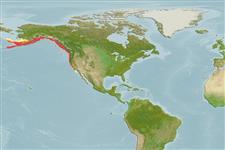Environment: milieu / climate zone / depth range / distribution range
Ökologie
seewasser demersal; tiefenbereich 18 - 425 m (Ref. 6793). Temperate
Northeast Pacific: Bristol Bay, Alaska to Unimak Island in the Aleutian chain and Point Montara, California, USA (Ref. 6793); extended to southeastern Bering Sea (Ref. 51659).
Size / Gewicht / Alter
Maturity: Lm ? range ? - ? cm
Max length : 20.0 cm TL Männchen/unbestimmt; (Ref. 2850)
Rückenflossenstacheln (insgesamt): 8 - 9; Rückenflossenweichstrahlen (insgesamt): 6-9; Afterflossenstacheln 0; Afterflossenweichstrahlen: 10 - 12; Wirbelzahl: 35 - 37. Dorsal fins touching or nearly so; caudal rounded; anal long based and rather low; pectorals broad, lower 4 to 6 rays thickened and not joined by membrane as far as their ends; pelvic fins reduced (in males, long pelvic fins reaching as far as the origin of the anal fin) (Ref. 6885). Dark gray or brown on upper surface, paler beneath, the line of demarcation very clear on head; some individuals with 6 or more dark saddle-shaped markings over back and extending on sides; dorsal fins with dark bands following free margins on fins; longitudinal dark coloring follows rays of caudal fin, especially at distal ends; rows of dark spots on rays of pectorals, and a bright orange spot in its center; dark spots on eyeballs more abundant on upper part (Ref. 6885).
Found on soft bottoms (Ref. 2850).
Life cycle and mating behavior
Geschlechtsreife | Fortpflanzung | Ablaichen | Eier | Fecundity | Larven
Eschmeyer, W.N., E.S. Herald and H. Hammann, 1983. A field guide to Pacific coast fishes of North America. Boston (MA, USA): Houghton Mifflin Company. xii+336 p. (Ref. 2850)
IUCN Rote Liste Status (Ref. 130435)
Bedrohung für Menschen
Harmless
Nutzung durch Menschen
Mehr Information
NamenSynonymeMetabolismusRäuberÖkotoxikologieFortpflanzungGeschlechtsreifeAblaichenSpawning aggregationFecundityEierEientwicklung
ReferenzenAquakulturAquakultur ProfilZuchtlinienGenetikElectrophoresesVererbbarkeitKrankheitenVerarbeitungNutrientsMass conversion
PartnerBilderStamps, Coins Misc.LauteCiguateraGeschwindigkeitSchwimmstilKiemenoberflächeOtolithsGehirngrößeSehfähigkeit
Tools
Zusatzinformationen
Download XML
Internet Quellen
Estimates based on models
Preferred temperature (Ref.
123201): 2.9 - 8.6, mean 5.3 °C (based on 283 cells).
Phylogenetic diversity index (Ref.
82804): PD
50 = 1.0000 [Uniqueness, from 0.5 = low to 2.0 = high].
Bayesian length-weight: a=0.00389 (0.00180 - 0.00842), b=3.12 (2.94 - 3.30), in cm total length, based on all LWR estimates for this body shape (Ref.
93245).
Trophic level (Ref.
69278): 3.2 ±0.3 se; based on size and trophs of closest relatives
Widerstandsfähigkeit (Ref.
120179): mittel, Verdopplung der Population dauert 1,4 - 4,4 Jahre. (Preliminary K or Fecundity.).
Fishing Vulnerability (Ref.
59153): Low vulnerability (10 of 100).
